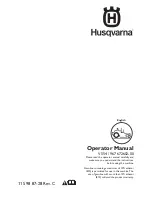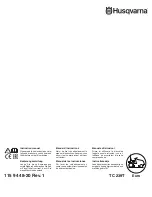
Section 4: Adjustments
10/26/17
21
Section 4: Adjustments
Leveling the Mower
Refer to Figure 4-1:
1.
Set lower hitches and upper floating hitch, as shown.
2.
Start tractor and raise mower while watching tractor
draw bar (if not removed) to make sure it does not
interfere with driveline and mower.
3.
Slowly lower mower until gauge wheels touch the
ground and the lower mower 3-Point hitch bars are
parallel to the ground in floating position. Set tractor
3-Point stop.
4.
Set park brake, turn off tractor, and remove key.
5.
Rotate blades parallel to direction of travel.
6.
Measure clearance from the blade cutting edge to the
ground at the front and rear of the mower. These two
measurements should be equal or the blade at the
front should not be more than 1/2" lower than the
blade at the rear. The rear blade should not be lower
than the front blade.
3-Point Hitch
Figure 4-1
Cutting Height Adjustment
!
WARNING
To prevent serious injury or death:
!
CAUTION
To prevent serious injury:
Wear a pair of gloves when checking cutting height. Avoid
direct contact with cutting edge of blade.
1.
Using the tractor, raise mower off the ground, and
support under it with secure blocking to keep the
mower from drifting down during maintenance.
2.
Holding wheel and yoke assembly up, remove quick-
lock pin from top of gauge wheel spindle.
3.
Position full length spacers and half spacer as
required. All spacers on top of spindle tube allows for
approximately 3/4" cutting height. Adjustments range
from 3/4" to a maximum of 5-1/4" in 1/2" increments.
Refer to
on this page.
NOTE:
Tractor & mower should be on level ground.
20829
3-Point Hitch Adjustments
Refer to Figure 4-1:
The 3-Point hitch system on this mower has been
designed for front to back flotation when mowing on
uneven terrain. Adjust the tractor’s top link to place the
upper hitch pin vertically above the lower hitch pins as
shown in.
Belt Tension
!
WARNING
To prevent serious injury or death:
!
CAUTION
To prevent serious injury:
Refer to Figure 4-2:
1.
To check tension apply force at arrow
A
with a
tension tester and deflect the belt 1/4". The force
required to get this deflection should range from
7 to 10 lbs.
2.
To adjust belt tension, adjust eyebolt (#1), as
necessary. This adjustment will increase or decrease
the tension on spring (#2). If more tension is needed
than the eyebolt can adjust take the tension
spring (#2) to next link in the tension chain (#3).
3.
Excessive tension on the belt may lead to premature
failure of belt and drive components. Excessive
tension on the belt may also lead to a safety hazard
to the operator or bystanders. Not enough tension on
the belt may lead to premature failure of the belt due
to excessive slipping.
Belt Tension
Figure 4-2
1/2 SPAN
A
20832












































